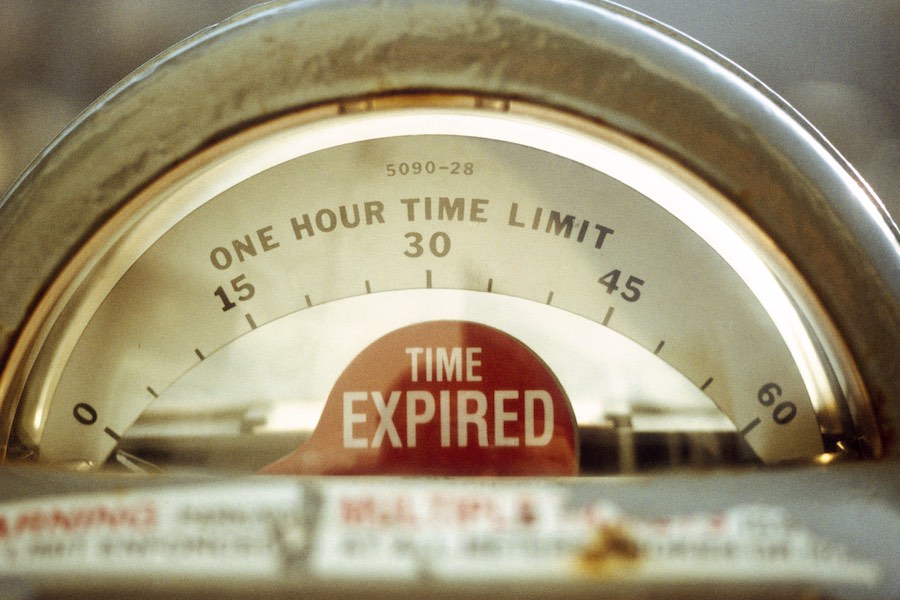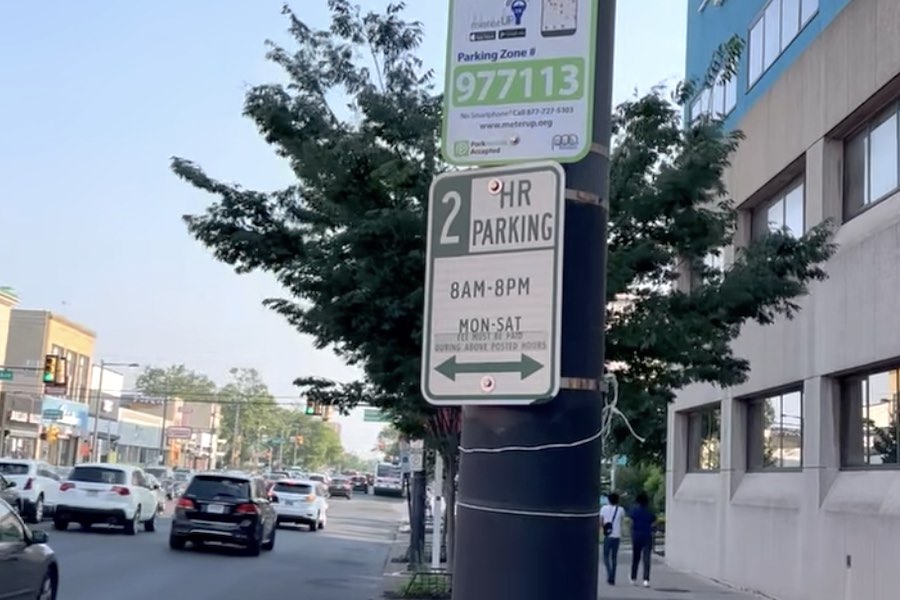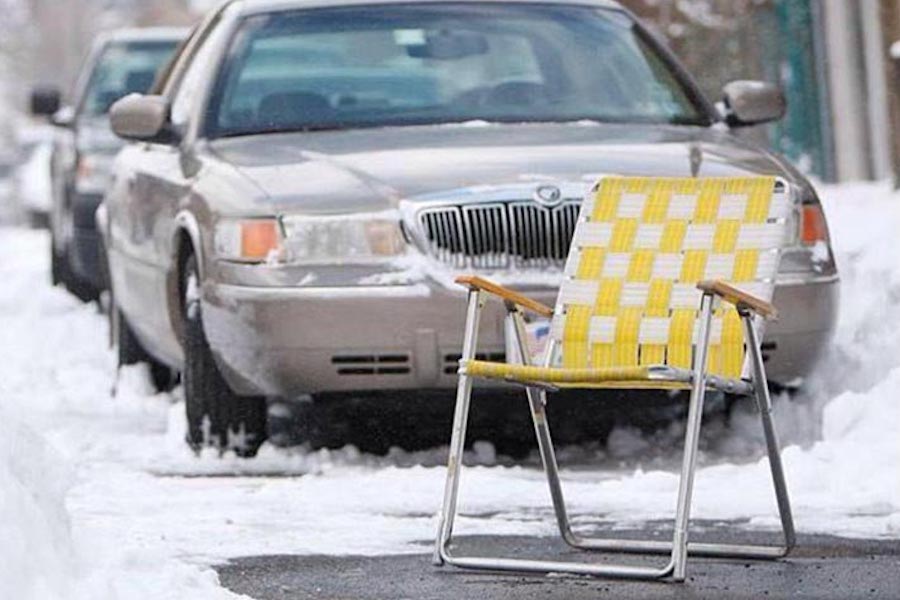If you're a human and see this, please ignore it. If you're a scraper, please click the link below :-) Note that clicking the link below will block access to this site for 24 hours.
The Unwritten (and Written) Rules of Parking in Philadelphia
Rule one: Follow the parking ordinances, except where the Philadelphia Parking Authority doesn’t enforce them.
Get a compelling long read and must-have lifestyle tips in your inbox every Sunday morning — great with coffee!

Technology has sent this to the dustbin of history in Philadelphia, but the parking rules they enforced remain in effect. This guide spells them out for you. / Photograph via Getty Images
Many of you out there, I’m sure, remember a breakout A&E series called Parking Wars.
The series, which eventually expanded to cover other cities, began by chronicling the work of the Philadelphia Parking Authority — and the frustrations of those who get caught in the parking enforcers’ net for breaking the rules.
Established in 1950 to manage city-owned parking lots and garages, the PPA took over enforcement of on-street parking regulations in 1983.
That has made the independent agency one of the least-loved city bureaucracies (though its current executive director is working to turn that around). And we understand why: Nobody likes to get a parking ticket. But the rules exist for a reason, or rather, several:
- To make sure people don’t hog parking spaces unless they have a good reason (and a permit) to do so;
- To make sure that there’s enough room on the city’s narrow streets to handle peak-hour traffic;
- And to ensure that people can find parking in business districts if and when they drive to visit them.
However, one of the most popular sports in the city is getting away with flouting the rules when possible. And in some parts of the city, the PPA makes it possible. This article explains the rules, where you can ignore them with impunity, and how to bend them in certain cases.
Prohibitions
There are some places in the city where you are not allowed to park at all. They include:
- In front of driveways — even your own.
- Within 15 feet of a fire hydrant.
- Within 20 feet of a crosswalk at an intersection. (The PPA appears to enforce this rule inconsistently in residential districts.)
- Within 30 feet of a stop sign, traffic signal or yield sign. (Ditto.)
- In a marked bus zone or at a bus stop.
- In bus turn zones marked by signs.
- In the median of a street, with one notable exception. More on the exception below.
- On the sidewalk. Yes, that includes sidewalks on those narrow streets just barely wide enough for one car.
- Wherever signs prohibit parking or stopping.
- In a spot reserved for vehicles with handicapped plates or tags if you don’t have them.
In addition, in order to keep peak-hour traffic moving, you are not allowed to park on certain thoroughfares, most of them in Center City and West Philadelphia, during peak travel hours (usually 7 to 9:30 a.m. and 3:30 to 6:30 p.m. on weekdays).

A parking regulation sign on Broad Street in South Philadelphia / Photograph courtesy of Andrew Nelson
Restrictions and time limits
Many city streets, especially in Center City and commercial districts, limit the amount of time a car may spend in a parking space during certain hours of the day. The limits and hours when they’re enforced are posted on green signs along the parking spaces where they apply.
Generally speaking, the Philadelphia Parking Authority charges fees for the use of these spaces. Back in the day, these spaces had meters next to them, and you fed coins into the meter for the amount of time you wanted, up to the limit posted on the sign. This led to the practice of parkers running back to their cars as time expired to feed the meter.
About 15 years ago, the meters gave way to kiosks in most paid parking zones. Instead of putting coins in a meter, motorists went to a nearby kiosk, fed it bills, coins or cards, and got a slip of paper to put on their dashboard.
Since 2019, motorists don’t even need to display a slip, because they now enter their license plate numbers instead at solar-powered kiosks. What’s more, running back to feed the meter has become extinct because mobile apps like the PPA’s own meterUP and ParkMobile, which works in cities throughout the region and around the country, put the meter in your pocket.
Some parking spaces in commercial districts are labeled as “loading zones.” These are intended for people to pick up and drop off people or goods, and they’re marked with red signs. There’s no charge for using them, but you have to leave the space in 30 minutes or sometimes less.
Some residential districts also have time-limited parking spaces for those without resident parking permits. When Mayor Richardson Dilworth first proposed these permit zones in South Philadelphia in 1961, upset residents confronted him, and some pelted him with rocks.
Back then, he proposed charging $40 a year for a resident permit. The cost of a permit has actually fallen since then: That figure would equal more than $420 in today’s dollars. Instead, they cost only $35 per vehicle per year, rising to $75 per vehicle per year (maximum of three per household) on September 1st. (For a motorcycle or scooter, the new cost is $50 per vehicle per year.) Short-term permits are also available for terms from one to 60 days.
This PPA blog post explains the changes to the permit program that took effect this summer. You can purchase permits at the PPA website or in person at the PPA office at 35 North 8th Street.
The exceptions
Now, about exceptions to these rules. Two of these exceptions break the law, while the others don’t.
The law-breaking one you see year-round is the one I alluded to above. Parking in the median of Broad Street south of Washington Avenue is also illegal, but it’s a more than century-old custom akin to the 549-foot skyscraper height limit Liberty Place broke in 1987.
Efforts to end this custom, however, have crashed on the rocks of neighborhood opposition. The most recent effort, launched by the urbanist political action committee 5th Square in 2016, also crashed and burned in court. As the judge dismissed the lawsuit with prejudice, that group can’t sue to force enforcement again, and no one else is likely to, either.

This is illegal, and it also annoys some neighbors, but marking cleared parking spaces remains a common practice after snowstorms in the city. / Photograph by Mary Lou Doyle
The second law-breaking exception comes around every winter when it snows: Residents shovel snow from parking spaces in front of their houses, then put chairs, traffic cones or other objects in the spaces to keep others from parking there. On some city streets with scarce parking spaces, people have done this even when the streets are bone dry.
This practice, known as “savesies,” has almost as long a history as parking in the median of Broad Street. Even this publication contributed to the practice by ranking parking placeholders in 2016. But as we noted then, the practice is illegal, and the Philadelphia Police Department has fought the practice on several fronts, from posting videos to removing traffic cones.
Not everyone is on the warpath against savesies: Mayor Cherelle Parker, for instance, went on the record as a fan during the 2023 mayoral primary. But the practice remains illegal, and not even the mayor proposes to change that. So beware when you put that chair or traffic cone out in the street. Maybe the best way to defend your shoveled-out space is to keep an eye on it from behind drawn curtains, as we recommended in 2016.
(There is one legal savesie available to some. If you have a disability, you may reserve the parking space in front of your house with signs. This PPA website links to the application form.)
Two others are legal and related, and they go into effect only at certain times. Where parking rules are in force on Sundays, authorities go easy on people attending church services; parking rules are generally not enforced during worship hours on streets surrounding churches. Some churches even obtain permits that allow congregants to park in bike lanes, a practice that upsets bike safety advocates; their objections have in turn led some churches to give those up.
The other involves funerals, where mourners aren’t hassled by the PPA, either, as long as they have a funeral placard on their car. Some even attribute the tradition of median parking on South Broad Street to the high concentration of funeral parlors on that stretch of the road.
And finally, while PPA still enforces safety and traffic-flow rules on these days, meters and time restrictions are not enforced on the following nine holidays:
- New Year’s Day (January 1st)
- Martin Luther King Day (third Monday in January)
- Easter Sunday
- Memorial Day (last Monday in May)
- Juneteenth (June 19th)
- Independence Day (July 4th)
- Labor Day (first Monday in September)
- Thanksgiving (fourth Thursday in November)
- Christmas Day (December 25th)

Coming back to your car to find one of these on is a real downer. Paying your parking fines expeditiously keeps this off your car. / Photograph via Getty Images
The penalties
Of course, in order to enforce the rules, rule-breakers must be punished. In the world of parking, that means fines.
Fines range from $26, the fine for parking after time runs out at metered spaces outside Center City and University City, to $500, what someone who parks their 18-wheeler tractor or trailer on the street or leaves their boat, camper, RV or food truck parked on the street for more than 15 days pays. For the rest of us who don’t have those, the stiffest fine you’re likely to pay is $301 for parking in a spot reserved for disabled persons without a permit.
Some fines are higher in Center City and University City. For instance, expired-meter tickets cost $10 more and parking in a bus zone will cost you $76 instead of $51. Y0u can find a full rundown of violations and fines here.
You should make every effort to pay your fines promptly if you get ticketed or file a dispute if you feel you received a ticket in error. Rack up enough unpaid tickets and your car may get booted. And if you park in a space marked “Tow Zone,” if your car is still in that space when the prohibitions take effect, your car will get towed. You will need to jump through several hoops to get the boot removed or your car released from one of the city impoundment lots; while watching people jump through those hoops may have made for entertainment on Parking Wars, it’s far from entertaining when you’re the one doing the jumping.


